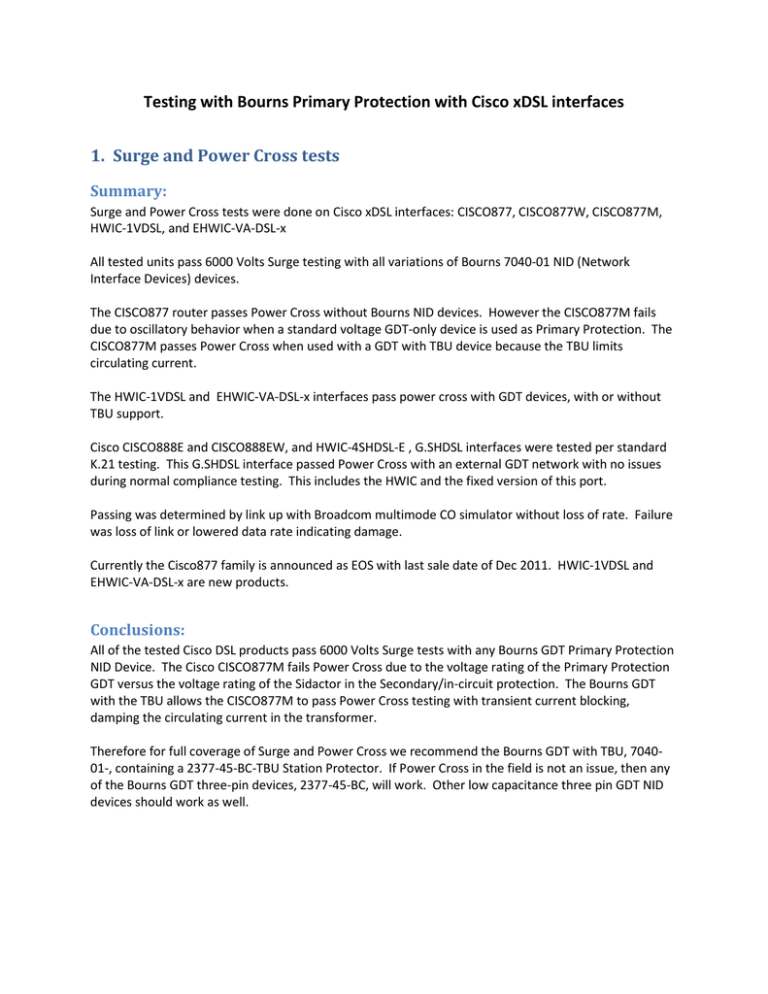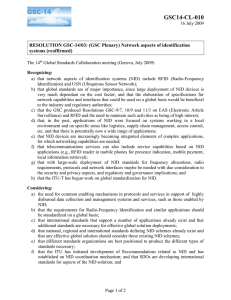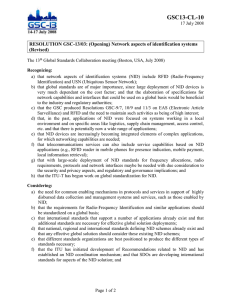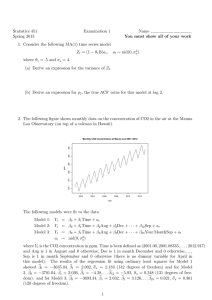Testing with Bourns Primary Protection with Cisco xDSL interfaces Summary:
advertisement

Testing with Bourns Primary Protection with Cisco xDSL interfaces 1. Surge and Power Cross tests Summary: Surge and Power Cross tests were done on Cisco xDSL interfaces: CISCO877, CISCO877W, CISCO877M, HWIC-1VDSL, and EHWIC-VA-DSL-x All tested units pass 6000 Volts Surge testing with all variations of Bourns 7040-01 NID (Network Interface Devices) devices. The CISCO877 router passes Power Cross without Bourns NID devices. However the CISCO877M fails due to oscillatory behavior when a standard voltage GDT-only device is used as Primary Protection. The CISCO877M passes Power Cross when used with a GDT with TBU device because the TBU limits circulating current. The HWIC-1VDSL and EHWIC-VA-DSL-x interfaces pass power cross with GDT devices, with or without TBU support. Cisco CISCO888E and CISCO888EW, and HWIC-4SHDSL-E , G.SHDSL interfaces were tested per standard K.21 testing. This G.SHDSL interface passed Power Cross with an external GDT network with no issues during normal compliance testing. This includes the HWIC and the fixed version of this port. Passing was determined by link up with Broadcom multimode CO simulator without loss of rate. Failure was loss of link or lowered data rate indicating damage. Currently the Cisco877 family is announced as EOS with last sale date of Dec 2011. HWIC-1VDSL and EHWIC-VA-DSL-x are new products. Conclusions: All of the tested Cisco DSL products pass 6000 Volts Surge tests with any Bourns GDT Primary Protection NID Device. The Cisco CISCO877M fails Power Cross due to the voltage rating of the Primary Protection GDT versus the voltage rating of the Sidactor in the Secondary/in-circuit protection. The Bourns GDT with the TBU allows the CISCO877M to pass Power Cross testing with transient current blocking, damping the circulating current in the transformer. Therefore for full coverage of Surge and Power Cross we recommend the Bourns GDT with TBU, 704001-, containing a 2377-45-BC-TBU Station Protector. If Power Cross in the field is not an issue, then any of the Bourns GDT three-pin devices, 2377-45-BC, will work. Other low capacitance three pin GDT NID devices should work as well. 2. Surge Tests Surge testing was done with three versions o f Bourns 7040 NID (Network Interface Devices) family, each containing a Station Protector module. Two of these modules are Gas Discharge Tubes without TBU® sneak current blocking and one with a TBU®. The Surge Test is a standard 10/700 us waveform based on the ITU-T K.44 generator and applied in accordance with ITU-T K.21. The test voltages were 4000 Volts and 6000 Volts. Each voltage was applied 5 times each in the positive and negative polarity. 6000 Volts is the maximum voltage of the Key Tek ECAT, Module E502B. 2.1.Bourns NID devices tested The NID box part numbers as follows: 7040-01-W with a 2377-45-BC-IDT GDT Station Protection Device as shown in the data sheet below. 7040-01-Z with a 2377-45-BC GDT Station Protection Device as shown in the data sheet below. 7040-01-S01 (temporary nomenclature) with a GDT-TBU balanced GDT Station Protection Device now listed by Bourns as 2377-45-BC-TBU as shown in the image below. Both the –W and the –S01 NID box use IDC , insulation displacement connectors. The –Z uses 2 threaded posts, 1 post for Tip In/Out and 1 post for Ring In/Out. All have a Grounding post. Image of 2377-45-BC-TBU Station Protector. Data Sheet for 7040 series NID boxes with 1 or 2 Station Protector modules 2.2.CPE Equipment Tested The CPE equipment tested was the CISCO800 series ADSL2+ routers, CISCO877M and CISCO877, and VDSL2 modular HWICs and fixed cards. All are Annex A or M (over POTS) routers with a RJ11 Tip and Ring Interface. The NID device was connected between Tip and Ring and the NID Ground connector was connected to Test Ground. Previous testing indicates that the failure voltage on the DSL isolation transformers is approximately 4000 Volts. Data sheets indicate that the tested voltage is 1500 Volts. At voltages above the 4000 Volt level, and if a return path found, the transformer will be shorted and components on the tertiary side damaged. 2.3.Grounding All three of the test NID modules are three point systems: Tip and Ring In, Tip and Ring out, and Ground. Since the CISCO800 family of routers is ground isolated by design, the Ethernet connections were all bonded together and grounded to mimic a high impedance path to ground during the tests. This was done to imitate EOS where the failure path was through the Ethernet cable to a grounded PC. 2.4.10/700uS Surge Generation The Surge generator was attached to Tip and/or Ring and Ground depending on the test configuration. Both Longitudinal (earth/ground to Tip and Ring) and Metallic (signal between Tip or Ring with Ring or Tip connected to Surge Return and ground). The peak voltage and peak current were monitored at the surge generator. 3. Surge Test Results All three NID packages operated about the same when tested in either Longitudinal or Metallic configuration. The recorded peak voltages measured at Tip or Ring were the same for each Surge Pulse. There were no CPE unit failures with any of the three versions of the NID interface. The highest voltage sustained by the CPE was with the 6000 Volt pulses, positive and negative polarity, allowing approximately 800 Volts peak to appear at the Isolation transformer primary winding. This is about 0.2 of the maximum voltage sustainable at the transformer. This is due to the response of the GDT. A representative section of the results is below: Grounded Ethernet F3 Longitudinal T/R to GND V A 833 457 838 459 834 452 840 455 838 462 V 0 1 2 1 1 1 1 1 2 1 A -460 -825 -460 -826 -452 -819 -465 -818 -466 -799 with Ethernet F3 and Shield Differential/Metal T-Gnd/R Grounded V A V A 683 1 -284 -71 -70 -70 -75 -78 -75 -78 -78 -78 -79 Polarity 6KV -6KV 6KV -6KV 6KV -6KV 6KV -6KV 6KV -6KV -78 Polarity 6KV 278 678 282 684 281 700 293 687 282 1 2 1 2 0 0 0 0 1 -672 -283 -689 -286 -693 -286 -774 -285 -699 -76 -78 -78 -77 -76 -78 -68 -78 -78 Differential/Metal R-Gnd/T with Ethernet F3 and Shield Grounded V A V A 759 1 -285 -71 266 0 -763 -79 771 1 -282 -78 247 2 -762 -70 782 1 -283 -79 281 0 -828 -76 779 2 -585 -78 276 1 -750 -77 769 1 -285 -79 278 1 -767 -79 -6KV 6KV -6KV 6KV -6KV 6KV -6KV 6KV -6KV Polarity 6KV -6KV 6KV -6KV 6KV -6KV 6KV -6KV 6KV -6KV Surge tests were also done using the Bourns NID boxes on EHWIC-VA-DSL-x and HWIC-1VDSL and there were no failures. 4. Power Cross Experiments in the manner of GR-1089 requirements 4.1. Experimental Setup Power Cross was done in accordance with the test procedures of ITU-T K.21, ITU-T K.44 and GR-1089. This test is performed using a 600 V, 60 Hertz AC supply with a source (limiting) impedance of 600 Ohms for 1 second. The 600 Volt are applied both tip and ring in Longitudinal and 600 V Return/Ground connected to NID Ground terminal. In Metallic configuration, Tip is connected to 600 V and Ring is connected to 600 V Return/Ground and NID Ground terminal. The metallic configuration was repeated with Ring connected to 600 V and Tip is connected to 600 V Return/Ground and NID Ground terminal. The Bourns 7040-01-Z or 7040-01-x with TBU Station Protector NID box was between the Power Cross generator and the CPE equipment. The xDSL equipment tested: CISCO877 CISCO877M. EHWIC-VA-DSL-x 4.2.Results Results Summary: Cisco877M failed with GDT Primary Protection 7040-01-Z or -W, but passes without GDT only Primary Protection, and passes with GDT-TBU Primary Protection. Cisco877 Passed with all NIDs. HWIC-1VDSL Passed with all NIDs. EHWIC-VA-DSL-x Passed with all NIDs. CISCO877 passed with no loss of performance. The CISCO877M with either the 7040-01-W or 7040-01-Z NID failed with either loss of performance leading to failure or failed with full loss of performance after one or two pulses.









